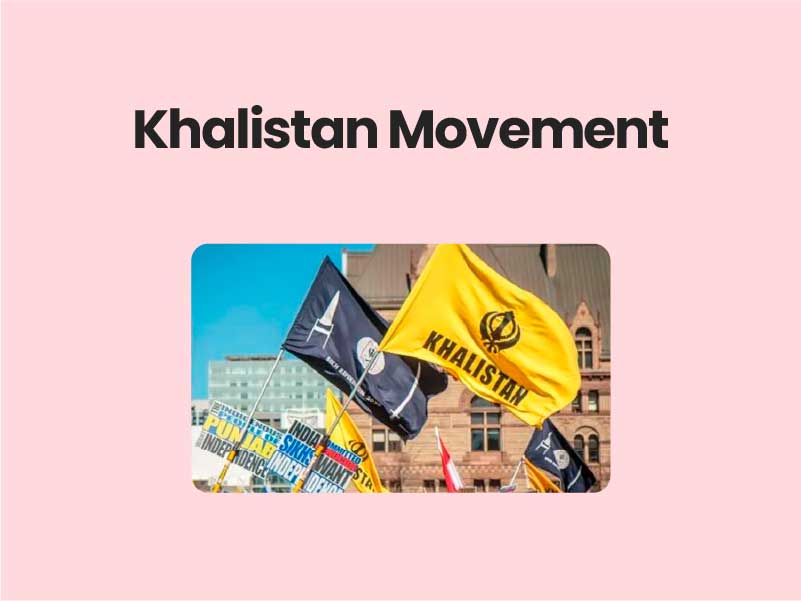Companion@360 → 7 Month programme to sharpen your writing skills → REGISTER NOW

Khalistan Movement
The Khalistan movement is a Sikh separatist movement seeking to create a homeland for Sikhs by establishing a sovereign state, called Khalistān in the Punjab Region. Such a state existed in Punjab from 1709 to 1849.
Objectives of Khalistan Movement:
1- To create independence state- Khalistan.
2- Self Home Rule.
3- Anti-Nationalism.
Historical events responsible for Khalistan:
- 1947 Partition of India –Independence of India was not a joyful event for Sikhs, partition left Sikhs in a lot of discontentment with regard to their traditional lands being lost to Pakistan.
- The fight for a separate Sikh state owes its origins to the Punjabi Suba Movement. The Akali Dal – a Sikh-dominated political party – sought to create a separate Sikh Suba or Province.
- When the States Reorganization Commission, constituted to assess the demand for separate states by linguistic groups, made its recommendations, it rejected the Akali Dal’s demand.
- But after a series of violent protests, the Indira Gandhi government relented in 1966.
- The state was trifurcated into Punjabi-majority Punjab, Hindi-majority Haryana and the Union Territory of Chandigarh. Some hilly regions of the state were merged into Himachal Pradesh.
- However, the Anadpur Sahib resolution reignited the passion of Sikhs and sowed the seeds of Khalistan movement
Causes:
- The Khalistan movement is a Sikh nationalist movement that wants to create an independent state for Sikh people, via armed struggle or political, inside the current North-Western Republic of India Such a state existed in Punjab from 1709 to 1849.
- The idea of Khalistan was an idea first created in 1940s, remained idle but was revived by an NRI seeking a separate homeland for Sikhs.
- In early 1980s, the movement had emerged as a major separatist movement, fed mostly by bias of Indian Government against Punjab in the case of Chandigarh and sharing of Ravi-Beas waters.
- There was intense political rivalry between Congress Party and the Akali Dal, Akali Dal was gradually gaining ground as the political representative of the Sikh community.
- Congress leadership of that time tried to divide the Akalis by propping up diverse groups of people within the Akali Dal.
- Jarnail Singh Bhindranwale led the Khalistan as an extremist movement, he was initially used by Congress to counter Akali Dal but later he was inspired by the Khalistan ideology and turned against Indian government.
- The movement was fed on arms under the patronage of Pakistan’s ISI who was seeking revenge for creation of Bangladesh.
- Bhindranwale emerged as the extremist voice of Sikhs, over-ruling the moderate voices of leaders declared himself as the protector and arbiter of Sikh rights and acquired arms.
- Demands for separate nation-hood for Punjab was carried out through violent protests and killings of high profile persons in Indian government.
Read GS 2 Notes India and Its Neighbourhood
Causes to fall Khalistan Movement :
1-Operation Blue Star one of the reason because Khalistan movement was headed by a terrorist group.
2-Diaspora of Sikhs community in India.
3-lack of support of the people as it was morally and ethically not viable.
4-.India saw Pakistan and US taking interest in the movement thus movement took an international colour which could compromise India’s territorial integrity.
Indo-Canadian relationship:
-
- An Indian-origin businessman Jaspal Atwalwas involved in shooting Punjab Minister as part of the Khalistan movement was claimed to be in the Canadian delegation to India.
- He was formerly associated with the banned Sikh separatists outfit International Sikh Youth Federation (ISYF), Itseeks to establish a separate country for the Sikhs of India called Khalistan.
- India declared the ISYF as a terrorist outfit and banned it under the Unlawful Activities (Prevention) Act in 2001.
- The outfit is also banned in Canada, United Kingdom and USA, which have sizeable Sikh populations.
- The Canadian PMO clarified that Mr. Atwal was not part of official delegation to PM’s visit to India, nor was he invited by the Prime Minister’s Office.
- It also claimed that as is the case with international trips, individuals sometimes travel on their own to the location of the visit.
The irrelevance of the Khalistan movement notwithstanding, agencies such as the Pakistan’s ISI have not stopped trying to foment violence, either directly by funding fringe sections or by linking them with terror groups in Kashmir.
Even if the Khalistan movement has been interred, the threat of terror in Kashmir remains well and truly active.
